Pentagon Rescue? Open Bloody Questions — An Essay in Four Parts
- Part 1: Were They Rescued from the Fire?
- Part 2: Were They Rescued from the Collapsing Building?
- Part 3: The Seven-Minute Fire
- Part 4: Treason in High Places
Sources of Information
In researching and composing this article, we used government and quasi-government sources, including:
- The DoD's American Forces Information Service (AFIS)
Original link:
http://www.defenselink.mil/afis/
2002 Archive:
https://web.archive.org/web/20020909100519/http://www.defenselink.mil/afis/
Cached:
http://holocausts.org/911/pentagon/AFIS-Home-Page.pdf - The AFIS's Defense Visual Information Center
Original link:
http://www.dodmedia.osd.mil/dvic/
2001 Archive:
https://web.archive.org/web/20010215012733/http://www.dodmedia.osd.mil/dvic/
Cached:
http://holocausts.org/911/pentagon/AFIS-DVIC.pdf - The Military District of Washington
Original link:
http://www.mdw.army.mil
2001 Archive:
https://web.archive.org/web/20010418173557/http://www.mdw.army.mil/
Cached:
http://holocausts.org/911/pentagon/mdw.pdf - Standard news coverage — Associated Press, Reuters, UPI, etc.
PART 1
Were They Rescued from the Fire?
June 23, 2002 — The recent movie Black Hawk Down deals with an
important lesson — the military has two jobs. The military must destroy the enemy's
forces and it must ensure the survival of its own soldiers. "Black Hawk Down (Leave No Man
Behind)" dramatizes a story of survival: the heroic efforts of soldiers who attempted to rescue
their fellows who were trapped behind enemy lines in Mogadishu, Somalia. The rescuers
themselves became trapped, and they, too, needed to be rescued.
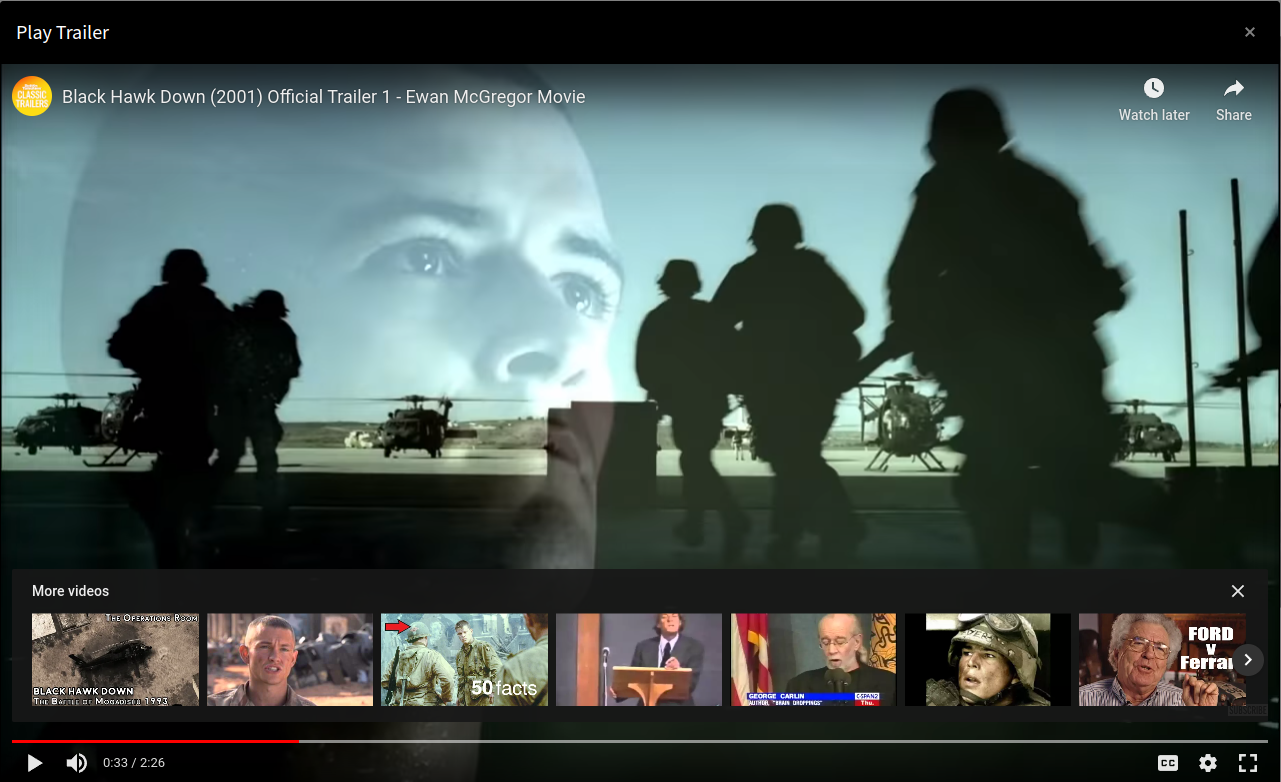
For about 140 minutes, Black Hawk Down ("Leave No Man Behind") deals with how much soldiers — from the generals down to the enlisted man — care about each other. We see soldiers risking their lives to get their wounded buddies, risking grenades, risking machine gun fire, risking rockets, risking belligerent mobs — all to rescue other soldiers. We hear dialogue that goes like this:
"No man gets left behind,"
"You all right?"
"No man gets left behind,"
"We won't leave you behind,"
"If he don't get to the hospital in ½ hour, he's in trouble!"
"No man gets left behind." (Bowden & Nolan 2001
At one point, two soldiers are talking about a helicopter crash. The dialogue goes something like this:
Soldier A: "There can't be any survivors!"
Soldier B: "We don't know that, we gotta go back and look!" (Bowden & Nolan 2001
At the conclusion of the movie, soldier hero Sgt. Hoot Gibson is asked why he risks life and limb in these military actions: Is he a war addict? Hoot replies:
"It's about the man next to you." (Bowden & Nolan 2001)
Camaraderie, being a team member — that's what the US military is about.
Or is it?
What would you think of a military that refused to rescue its soldiers from certain death — and then abandoned its control of the battleground to civilians?
Who would support such a military?
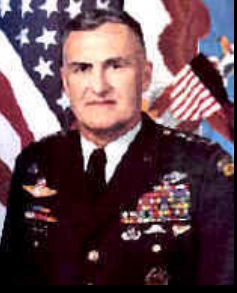
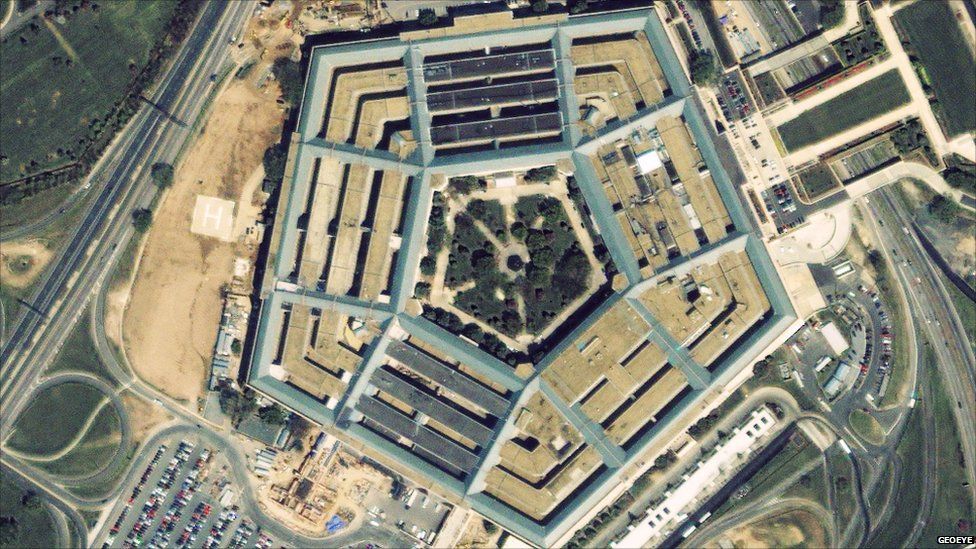
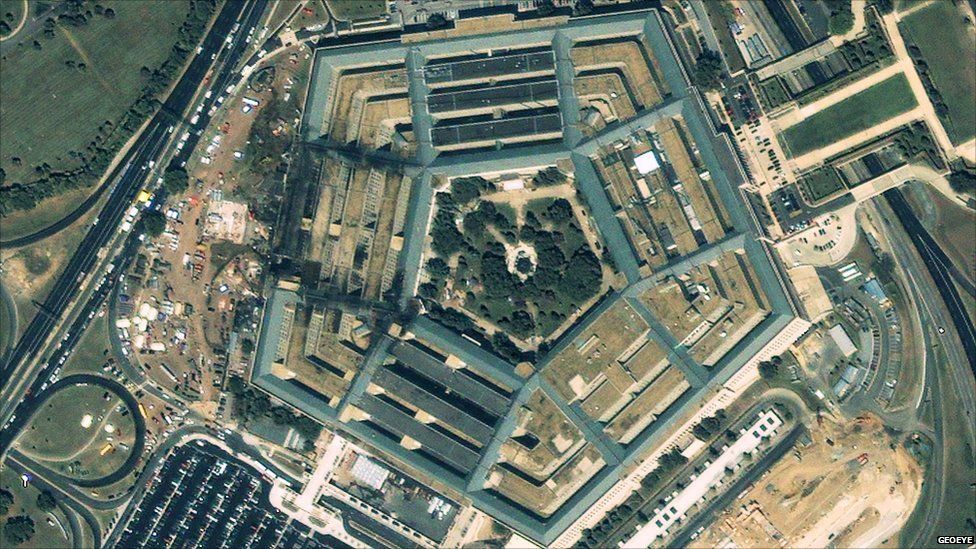
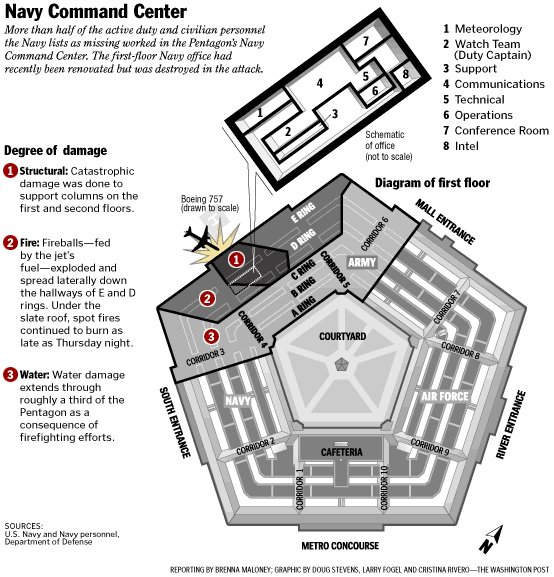
(Maloney, Stevens, Fogel, & Rivero
2001) Click to expand.
As you read this article, keep in mind that on September 11, the Chairman of the Joint Chiefs of Staff was General Henry Hugh Shelton. Shelton is a former Commanding General of the 101 and 82nd Airborne Divisions. He is a former Commanding General of the XVIII Airborne Corps and a former Commander in Chief of the Special Operations Command. It was Special Operations that conducted the "Black Hawk Down" mission in Mogadishu, Somalia. (Shelton 2001)
Let's have a look at Shelton's career highlights. On September 11, the top commander of the entire US military machine was intimately familiar with aircraft, aviation fuel fires, aircraft rescue, and the ideals depicted in Black Hawk Down.
However, those who directed the 9-11 rescue at the Pentagon did these amazing things:
- They sprayed the aviation fuel fire with water. Every housewife knows you don't spray water on a grease or oil fire; every firefighter knows you don't spray water on a liquid fuel fire—and that includes aviation fires.
- They allowed the fire to spread until the upper floors of the Pentagon collapsed, burying any survivors in the debris and further hampering their rescue.
- Once the upper floors collapsed, the directors of the rescue flouted standard rescue procedures for collapsed buildings. While there was still hope of finding survivors alive, they used a wrecking ball to demolish sections of the building still standing. Many additional tons of debris crashed down upon the already buried victims, almost certainly collapsing any spaces or voids in the wreckage that may have sheltered them.
- When qualified emergency medical technicians arrived by helicopter to rescue the victims, they were ordered to leave and forbidden to return. One wave of survivors was brought out, and then no more.
- One flimsy excuse after the other was used to stop the work and delay rescue operations.
- Civilian rescuers worked long shifts and became exhausted with wrongheaded methods. Meanwhile, thousands of able-bodied military personnel at nearby bases — including those specially trained in putting out aviation fires — sat and watched the drama on Tee Vee.
- Surviving military intelligence officers lost jurisdiction over military intelligence documents and those documents were collected by civilians who were not cleared to see them.
Meanwhile, the Pentagon front office made a media spectacular of the fire. Donald Rumsfeld and other Pentagon officials wrung their hands and cried, "How awful! How awful!" for days, stoking the public passion for war.
We believe that the desperate and exhausted rescuers we saw on TV intended the best and were trying to save lives. But they were relying on the leadership to make the decisions, and those leaders were operating on a different agenda. Among those people were:
- Gen. Henry Hugh Shelton, Chairman of the Joint Chiefs of Staff
- Donald Rumsfeld, Secretary of Defense
- Paul Wolfowitz, Deputy Secretary of Defense
- Rabbi Dov Zakheim, Undersecretary/Comptroller of DoD
- Secretary of the Army Thomas E. White
- Other commanders of the National Military Command Center
- Other "John Does" — persons whose names remain hidden from the public at this time.
Water Cannot Control Aviation Fires
Let us begin by accepting one of the Official Truths of 9-11: American Flight 77 crashed into the Pentagon, and exploding jet fuel caused an inferno. The fire obviously threatened the lives of those still in the building, and it threatened to spread. It had to be put out quickly.
Ordinarily, water is used to douse building fires. But water does not extinguish a liquid
petroleum fire. The fuel floats on top of the water and continues to burn. Instead of
water, special foams have been developed that float on the surface of the fuel and cut off the oxygen,
suffocating the combustion. The technical literature states that water is not "appropriate" for
"Class B" fires.
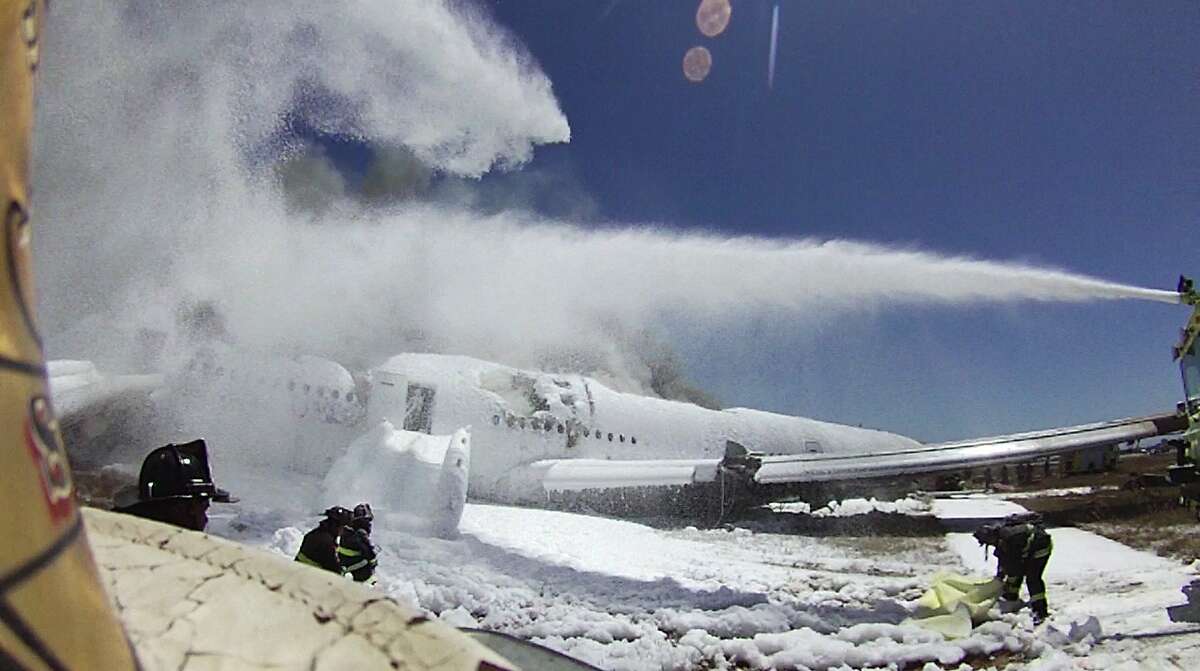
Class B comprises fires of liquid fuels - more precisely of the vapors in equilibrium with the liquids, such as oil, gasoline, alcohol, paints, varnishes, tar, and grease … Contrary to Class A fires, Class B fires proceed at the surface of the fuel, where to a more or lesser degree, the vapor phase of the liquid acts as the actual fuel. Appropriate means of extinguishing: powders, CO2, foam. [emphasis added] (Vinckier 2001)
Since aircraft are usually loaded with fuel, aircraft rescue and fire suppression crews routinely use
foam. As PBS (hosted at the University of Michigan) tells us:
… in a real crash, firefighters would use aqueous film forming foam (AFFF). The chemicals in AFFF mix with water and are "fluffed up" into a foam, but they won't mix with the fuel in a jet crash fire. This means the water can float on top of the fuel and smother the fire. [emphasis added] (Dave 2002)
In the above pages, notice the emphasis on speed in fighting fires. Aviation fire-and-rescue people have only about two minutes to rescue passengers before it is too late to help. And foam is THE tool of choice because it puts out liquid fuel fires efficiently.
FAA regulations require civilian airports to have firetrucks equipped to spray foam, and in the year 2000, the FAA cited the Detroit City Airport (now called "Coleman A. Young International Airport") for not complying with that regulation.
According to newspaper reports, Detroit City Airport firefighters had been asking the airport fire department for more foam because their supplies were low, but for weeks the firefighters received no response. Then, shortly after midnight on June 21, Secret Service agents notified City Airport firefighters to expect First Lady Hillary Rodham Clinton to arrive the next day on a Lear jet. Mrs. Clinton would be in Detroit for a $1,000-a-person fund-raiser for a New York Senate campaign.
The next day the firefighters got the 150 gallons of foam they had been requesting. (Claxton & Hurt 2000)
Water Was Used on Pentagon Flames
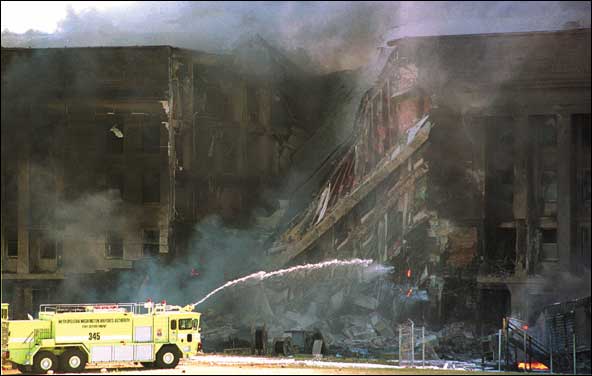
We have established that knowledgeable firefighters never use water to fight petroleum fires. However, here is what happened:
Search and rescue operations at the Pentagon, led by as many as 200 Arlington County firefighters and police assisted by a number of other jurisdictions, continue today. (USTranscom 2001)
The Military District of Washington published a photo showing the Metropolitan Washington Airports Authority Fire and Rescue Department spraying water on the Pentagon fire, with a caption identifying the spray as water.
Why, oh why, would they spray water when FAA regulations require airport firefighting trucks to use foam? It is inexplicable — unless, you consider the entire "rescue" mosaic.
For more photographs of the Pentagon firefighters, see Water Sprayed on
Pentagon Fire.
Millions of Gallons of Water — Fire Continues to Spread
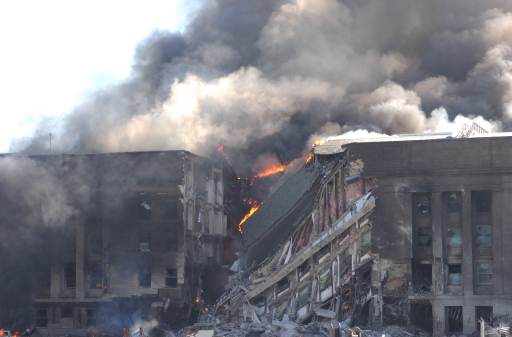
So much water had been poured into the building, the Pentagon later hired Munters Moisture Control Services to help get rid of it.
Millions of gallons of water flowed throughout the building after the attack," said Joe Kelley, Munters district manager in the Washington DC area. In some places, water was 18 inches deep on the floors. (Munters 2002)
What was the result of spraying water on a jet fuel fire? Predictably, the fire continued to spread.
DefenseLink stated that the attack on the Pentagon occurred at 9:38 am and, as smoke
billowed, evacuation began. Arlington County police and fire teams arrived and pumped water on
the blaze. Helicopters flew the seriously injured to hospitals. Then, DefenseLink
reported, the portion of the building to the right of the initial impact area
collapsed. (Garamone 2001)

The CNN 9/11 timeline states:
The American Forces Press Service coverage continues:
Fire continued to burn the Pentagon and spread in unrenovated sections. Flames ignited core materials in the layered roof and were particularly difficult to get at. Pools of aviation fuel would ignite occasionally and create thick black smoke over the building …
At 6:00 p.m., with the building still on fire … (Garamone 2001)
Was There Really a Jet Fuel Fire?
This photo shows firefighters from the Alexandria Fire Department spraying water on the debris.
Makes one wonder, doesn't it? Perhaps all these firefighters knew what we don't —
maybe there was no aviation fuel in the Pentagon that day… no aviation fuel means no
airplane, and no airplane means no truth in the Official Story. That's one explanation.
April Gallop was an Army administrative specialist on September 11, 2001, working at her desk
approximately 35-45 feet from the alleged point of impact of Flight 77. She heard a loud
explosion and was covered with debris. In a 2007 interview with Citizen Investigation
Team (CIT), Gallup described her fight to escape the ruins with her young child and attested
that she saw no passenger seats, no luggage, and no evidence of jet fuel.
|
Source caption: "In this 2007 interview by CIT, April Gallop describes how she was only a few dozen feet away from the alleged impact point of the Pentagon on 9/11 and barely survived. Her traumatic story of survival along with her two-month-old baby who was with her at the time is compounded by the utter failure of the government to provide the adequate assistance she needed to recover and put the pieces of her shattered life back together." The usual controls above enable the video and audio of the interview. |
The Internet Archive indicates the user "litetrip" uploaded the interview to Youtube in 2012. The trailing credits indicate the interview was conducted by Aldo Marquis of the Citizen Investigation Team in 2007 (Marquis & Titus 2007). But no mention of Gallup is found on the CIT site in 2022. The original domain mentioned in the credits, PentaCon.com, is disowned.
That Youtube video has been erased. YouTube states: "This video has been removed for violating YouTube's policy on hate speech. Learn more about combatting hate speech in your country."
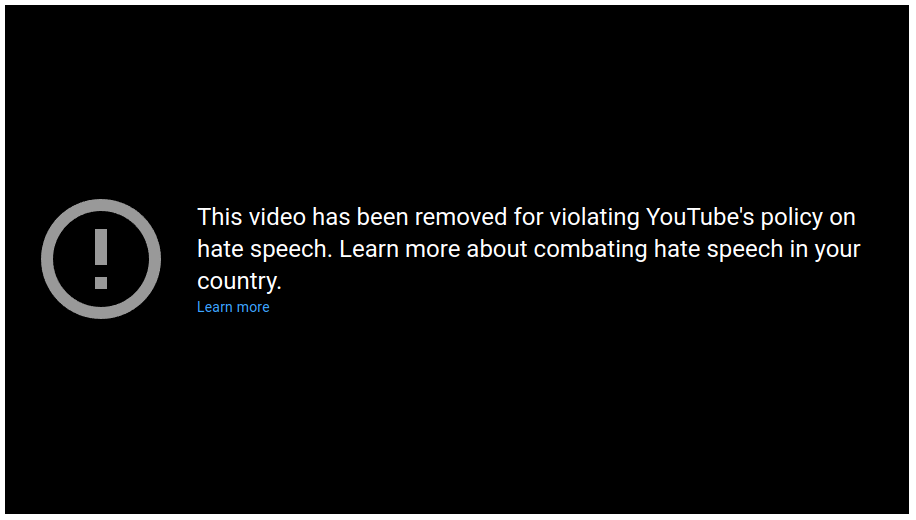 |
Military Firefighters Close to Pentagon
Andrews Air Force Base (home of Air Force One) is 9½ miles from the Pentagon
as the crow flies. Bolling Air Force Base is 1½ miles from the Pentagon.
Quantico Marine Base (home of Marine Helicopter Squadron One) is 23 miles from the
Pentagon. Each of those bases had airport firefighting equipment and trained teams at
the ready. Where were they when the Pentagon needed them?
Military Firefighters Fail to Show
(This subject will be covered in detail
in Part 3: The Seven-Minute Fire.)
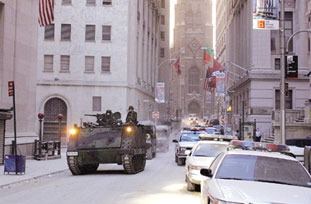
There should have been no problem getting aviation firefighters from Andrews, Bolling, or Quantico to the Pentagon to put the fire out and rescue their comrades. The soldiers in Black Hawk Down ("Leave No Man Behind") did not hesitate to crash through enemy lines, crowds throwing grenades, machine gun fire, rocket launchers, armed militia, etc., to rescue their comrades. The servicemen at Andrews, Bolling, and Quantico were in friendly territory. All they had to do was travel a few miles along the Beltway or Interstate 95.
So did the "leave no man behind" military show up to rescue their Pentagon comrades? No, it didn't happen.
As the photo at left shows (Business Week 2001), the US military was organized enough to have soldiers drive an armored personnel carrier (APC) down Wall Street in New York during the 9-11 crisis, but not organized enough to send aviation firefighters to the Pentagon.
Pentagon Watched 9-11 on CNN
Let's take a step back and look at what was happening before the event at the Pentagon. Let us rely on the DoD's own news service, the American Forces Press Service (AFPS).
According to AFPS, on the morning of September 11, the folks at the Pentagon were sitting around watching the WTC towers burn on CNN. (Garamone 2001)
When CNN announced the NYC strikes were an act of terrorism, did any of the Pentagon folks take appropriate action? Did they say:
"You don't suppose they'll send planes over here, do you? After all, those people are terrorists, and this is the Pentagon. We'd better call Andrews Air Force Base and get some air cover …"
No, the Pentagon folks just "exchanged shocked glances …" And presumably continued to watch the drama unfold on CNN.
"911? Help!
Pentagon Here!
We're Under Attack! Send
Civilians!"
BLAM! Flight 77 (allegedly) hits the Pentagon. What was the response? The American Forces Press Service report tells us:
Outside, the Arlington County police and fire departments arrived and started securing the area and pumping water on the blaze. (Garamone 2001)
But AFPS does not tell how the Arlington County Fire Department was alerted to the situation.
It may be that the Arlington County Fire Department had an agreement with the Pentagon to handle emergencies. Obviously, that agreement was made to handle everyday fires started by exploding Pentagon coffee pots or file cabinet fires. But should the Arlington County Fire Department handle acts of war on the Pentagon? The suggestion is just not credible.
And Pentagon personnel knew that the September 11 events were acts of war. They were watching CNN, and CNN had just told them.
No, the Pentagon officers should have ordered air cover for DC when the first news from New York broke.
Rumsfeld, Top Brass
Knew What Was Happening
It might be comforting to think that Rumsfeld, Shelton, and the top brass were all out playing golf that day and not on hand to see what was going on, but that was not true. The American Forces Press Service (AFPS) tells this story:
What is the National Military Command Center, mentioned above? That is the nation's focal point for continuous monitoring and coordination of worldwide military operations. (NMCC 2000)
So the top commanders of each of the services were on site. Each of the services uses aircraft and HAD to know that water does not extinguish aviation fuel fires. Yet all of them let the farce continue.
Fire as a Media Spectacular
Had the fire been put out quickly with foam, Rumsfeld would have lost valuable public relations mileage. The "stubborn" fire at the Pentagon was just one facet of a campaign designed to whip the American public and military into a bloodlust for a war on Islam. From a propaganda viewpoint, the higher the casualty list, the better.
The American Forces Information Service describes the press gala on September 11 this way:
Across Washington Boulevard from the Pentagon, the press set up shop at the navy Annex Exchange gas station and broadcast the fire fighting activities. With Correspondents' Corridor closed, reporters dictated stories using cell phones. TV trucks with antennae showed up and eased some of the communications problems.
At 6:00 p.m., with the building still on fire, Pentagon officials announced Rumsfeld would have a press conference in the Pentagon. Buses arrived at the gas station to take reporters, photographers, and videographers to the Pentagon.
Inside the River Entrance of the building, the smoke hit like a physical force. People could not see to the end of the hallways and it was tough to breathe. The smell of burning insulation and electrical wiring permeated the briefing studio.
As Rumsfeld, Chairman of the Joint Chiefs of Staff Army Gen. Henry Shelton, Senate Armed Services Committee chairman Sen. Carl Levin, ranking minority member Sen. John Warner, and Army Secretary Thomas White came into the studio, one side of the building was still on fire. (Garamone 2001)
"Rumsfeld expressed his sorrow over the loss of life at the building …" Do you believe Rumsfeld felt any grief over those he was doing nothing to help?
Rumsfeld's Crystal Ball:
"There Cannot Be Any Survivors"
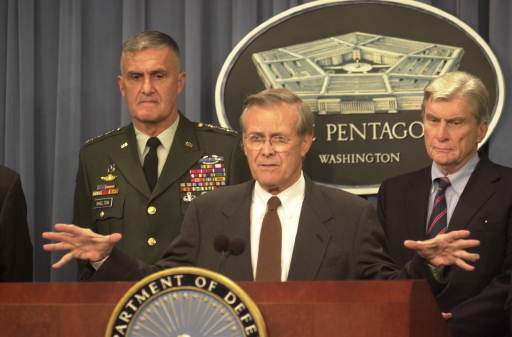
Emergency rescue experts say earthquake victims who are buried in debris can survive up to 12 days.
But in his September 11 press conference at 6:42 p.m., approximately nine hours after impact, Rumsfeld made this statement:
"There cannot be any survivors; it just would be beyond comprehension." (Rumsfeld 2001)
How could Rumsfeld KNOW that no more survivors would be found in the Pentagon debris? At that point, the Pentagon victims had been buried for only nine hours. Why the hurry to pronounce them all dead?
Gen. Shelton was at Rumsfeld's side during this press conference (at Rumsfeld's right in the photo above). He uttered pious statements about "barbaric terrorism carried out by fanatics against both civilians and military people, acts that have killed and maimed many innocent and decent citizens of our country." However, Gen. Shelton did not say a word about the rescue efforts that were murdering survivors.
He said:
Yes, our armed forces were ready, all right, Mr. Rescue Shelton. Ready to let civilian firemen squirt water on an aviation fuel fire while men died under the debris. And you stood by and watched … you watched it going on for days …
Aside from Rumsfeld, who spoke about the rescue efforts? Sen. Carl Levin, chairman of the Senate Armed Services Committee, uttered this inanity:
Rumsfeld's Predictions Come True
No survivors were found on September 12 and 13, or on any other day thereafter, just like Rumsfeld predicted.
Remember heat travels UP, not down. Those still buried in the rubble may well have been protected from the fire above them.
On September 14, the Pentagon announced 126 DoD personnel were dead. On September 15, the figure was lowered to 124 because two people had been double-counted. On October 11, 2001, when President Bush spoke at a Pentagon memorial service, he confirmed 125 DoD deaths. (Garamone 2001)
Remember Rumsfeld's words on September 11:
So Rumsfeld's predictions came true. After the first round of victims
escaped, there were no more survivors… He's quite a clairvoyant, isn't he? What
are the statistical chances of Rumsfeld being 100% right in circumstances like those?
Emergency Medical Help
Told to Get Out and Stay Out
We all know that when a person is seriously ill or injured, he must be given medical attention as soon as possible. Delay may cost the victim's life. That's why we have ambulances, and that's why ambulances have sirens.
On September 11, three members of a Washington Hospital Center MedStar Transport helicopter team responded to the emergency at the Pentagon. Several days later, (September 14) they were interviewed by Kathy Fowler of WJLA-TV (ABC Channel 7) in the Washington, DC area. Luckily, I have a copy of that interview on videotape.
The MedStar pilot and crew were among the very first at the scene, according to the WJLA report. When they arrived, they were told that another suicide plane was on the way and they should LEAVE.
How does that comport with the Black Hawk Down ("Leave No Man Behind") philosophy? Here we have civilians showing up to perform rescues and the military (or whoever was controlling the Pentagon scene then) ordering them to abandon the victims on the pretext of an unconfirmed and unfounded report.
The MedStar people, to their eternal credit, refused to leave. By the time they were ordered not to come back, they had helped eight victims and were taking another to the hospital. Speaking of the rescued victim, one of the crew told Fowler on camera:
Then Fowler told the audience:
So what we have is this: MedStar arrived and was immediately ordered to
leave. They refused, rescued eight people, took one to the hospital, and were prevented
from coming back.

Now, who would prohibit a MedStar helicopter to return to the scene of a disaster and take victims to
the hospital? Those MedStar helicopters should have been given military escorts to and from the
disaster site. What could be more important than immediate professional medical care for the
9-11 victims?
Park Police Doing Ambulance Service
Despite what the MedStar people were told, the air space was not quite as restricted as the Pentagon indicated. Official photographic evidence shows the civilian Park Police were commandeered to transport the injured after the trained and equipped MedStar crews were banned from the site.
It is of utmost importance that the injured should be moved only by trained people. Improper handling of an injured person can result in his death or permanent paralysis. In this photo, we see a Park Police helicopter doing "rescue" work. The Park Police are part of the National Park Service. They are not trained emergency medical people. Nor is the helicopter marked as emergency medical.
Why did they stop MedStar's trained professionals but deploy the National Park Service Police to handle the injured?
Concern for Civilians?
Perhaps you think that the MedStar team was chased away because those in charge of the crash site were concerned for the safety of civilians. If so, recall that civilian firemen were present at the scene, using water on a petroleum-fueled fire. They were not chased away.
Some, upon learning qualified emergency medical rescue people were turned away from the
Pentagon disaster site, may insist there "must" have been a good reason for keeping them
out. But a tree is judged by the fruit that it bears. So let's look at the
fruit.
Area Hospitals Surprised by
Low Number of Survivors
Area hospitals geared up to handle a large number of injured survivors and were
most surprised when few showed up.
But only about 80 people were treated at area hospitals, according to Walter Reed officials. At Virginia Hospital Center in nearby Arlington, over 100 nurses and 50 doctors were called in — 16 times the normal emergency staffing. They treated 44 victims in the first 24 hours, more than any other hospital in the region. But it was a mere trickle compared with what they expected. Inova Alexandria Hospital treated just 22 victims, 16 of whom were released Tuesday. Six patients were helicoptered from the Pentagon to Washington Hospital Center. "We got the first wave," says Marion Jordan, director of the hospital's renowned burn unit. "After that, nothing." In the end, his trauma teams treated about as many people as they would from a large house fire. (US News 2001, pg. 51)
What's wrong with this picture? Then lower on the same page:
Waiting for survivors Navy Lt. Charles McGill, 26, who had worked at the Pentagon for just four weeks, joined a group of people who calmly evacuated the massive building, then made his way around the perimeter to where dark, heavy smoke poured out. He lined up to be a stretcher-bearer. He and his fellow volunteers, four to a board, were told that during these first hours, only survivors would be moved. In three hours, no one came out. (US News 2001, pg. 51)
Then, on the next page:
Repeat:
Army "Supports" FBI and Fire Department
During Donald Rumsfeld's September 11 press conference, Secretary of the Army Thomas E. White spoke, thus:
What was White talking about? Who is the "them" White is referring to?

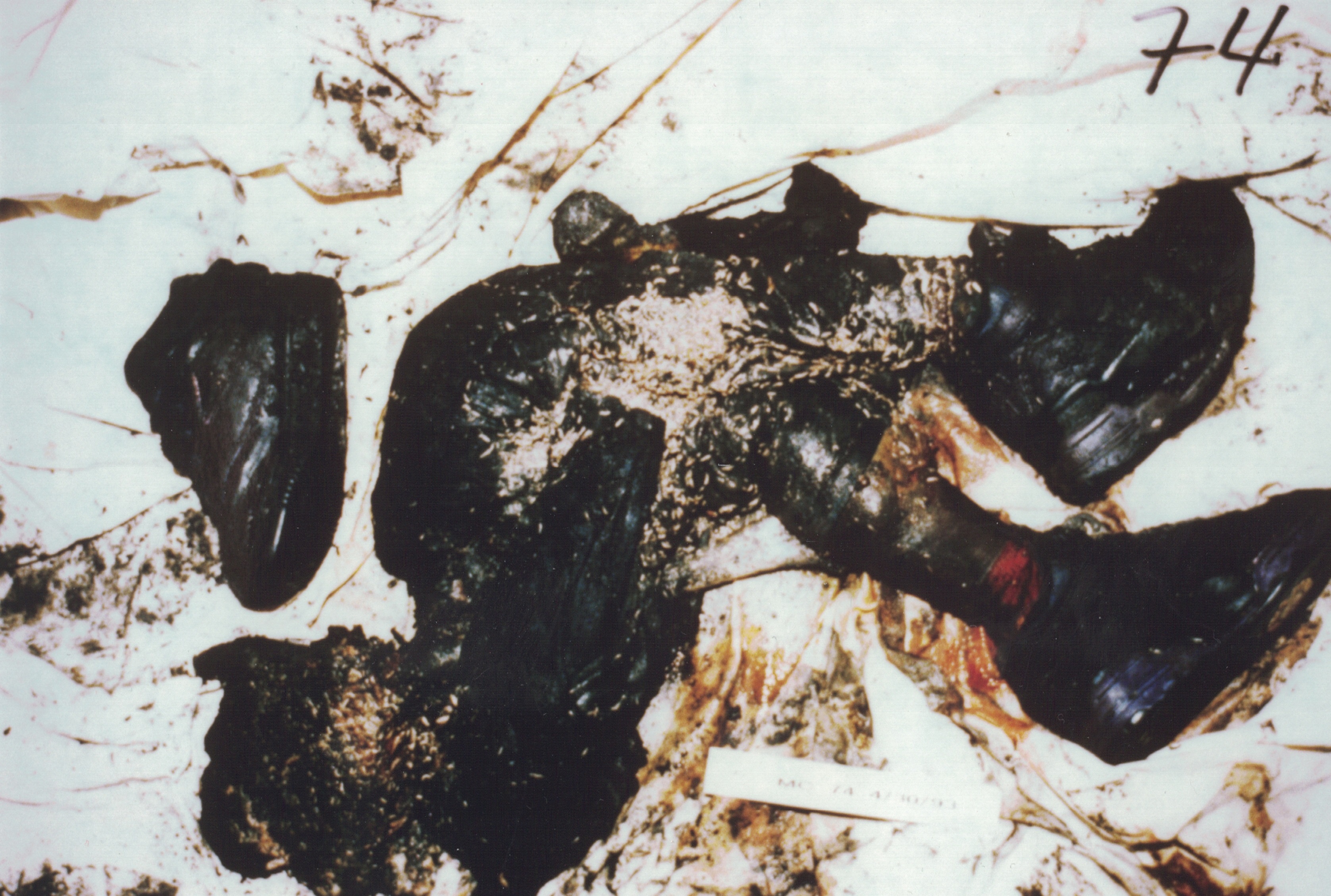
Obviously, White was referring to FBI agents. The FBI is going to rescue Pentagon personnel from "an act of war!" But FBI agents are not medically trained, they are not rescuers, and they are not warriors. They are assassins. Look at what they did to Melissa Morrison, a 7-year-old Davidian child, when they "rescued" her in Waco nine years ago:
Why would the Army transfer the rescue of Army personnel over to the FBI? Why weren't soldiers and Army medics rescuing other soldiers?
FBI Looking for Osama's Fingerprints?
Shortly after the 9:40 a.m. event, it was announced that the explosion and fire were caused by American Airlines Flight 77, which had been commandeered by terrorists and purposely flown into the Pentagon — conveniently missing the offices of Rumsfeld and the Joint Chiefs, of course. Putting out the fire and rescuing the buried victims should have been the first order of business. Surely the FBI did not need to take control of the site to look for fingerprints on the fuselage or other "clues." So why did the FBI have control of the site?
"Black Hawk Down" Meets Pentagon Down
We already know that when the 9-11 terror events were taking place, Gen. Shelton was out of the country. Surely he was informed by phone as the events were unfolding in the US. Surely he was in a position to issue commands to the armed forces:
By the time Rumsfeld gave his 6:42 press conference, Leave-No-Man-Behind Shelton was by Rumsfeld's and White's side, silent when Rumsfeld told the world the FBI had "secured" the war zone and was supervising the [non-] rescue. Remember, Shelton was a former commander of Special Operations Command, the "Black Hawk Down" people who performed so bravely in Mogadishu.
Of course Shelton knew about the Mogadishu rescue. The story first appeared as a series written by Mark Bowden, and ran in the Philadelphia Enquirer, in 1997. It was then published as a book. Here is what Leave-No-Man-Behind Shelton said to the author:
Eight hundred top Pentagon officials and military brass attended its Washington, DC premiere. It's hard to imagine the Chairman of the Joint Chiefs of Staff missed that event. This from The Nation:
According to Counterpunch, some Black Hawk Down actors were given Army Ranger Orientation Training at Fort Benning. (Sexton 2002)
Then the director, Ridley Scott, rushed the film's release after 9-11 (the movie was released on January 18, 2002); Scott earned a Pentagon commendation for doing so. (Worker's World 2002)
But what happened on September 11 at the Pentagon is directly opposite to the heroism depicted in the movie. Black Hawk Down ("Leave No Man Behind") is obviously what we're supposed to believe — that the lives of the grunt soldiers are precious to the commanders of the US military. But the observable truth, the truth that can be documented, is just the opposite.
Shelton, Rumsfeld, Wolfowitz, Zakheim, and the National Military Command Center treated the missing Pentagon personnel as dust motes. Black Hawk Down ("Leave No Man Behind") is obviously a piece of embroidery. The Pentagon sham rescue is verifiable fact.
Fire Used as Excuse to Stall Rescue
Of course the fires "stymied" the rescue. So why did they spray water on the fires? Two and three days after the crash, the fire was still a problem at the Pentagon.
Fire Used to Explain Deaths
So Rumsfeld and Company permitted water to be sprayed on a petroleum fuel fire, allowed more of the building to become involved in the fire, ordered emergency medical help off the scene, and failed to order military aviation firefighters to the scene. Now let's have a closer look at the progress of the fire/media event.
On September 12, we get these reports:
Late Thursday and flames were still erupting — that is almost 60 hours after impact, folks. How many building fires have you heard about lasting 60 hours?
Continued in Part 2: Were They Rescued from the Collapsing Building?
References for Part 1
- Bowden & Nolan. 2001
Black Hawk Down by Mark Bowden & Ken Nolan, Columbia TriStar, December 30, 2001.
- BBC News Services. 2011
"In pictures: Pentagon before and after 9/11," BBC News Services, 9 September 2011
URL: https://www.bbc.com/news/world-us-canada-14846156
2014 Archive: https://web.archive.org/web/20140712004611/https://www.bbc.com/news/world-us-canada-14846156
Cached: http://holocausts.org/911/rescue/Pentagon-BBCNews.pdf
- Burns. 2001
"Pentagon Says About 190 People Dead" by Robert Burns, AP Military Writer, Associated Press, September 13, 2001
URL: http://www.nytimes.com/2001/09/11/national/a-nation-challenged.html?mcubz=1
2017 Archive: https://web.archive.org/web/20171213015227/http://www.nytimes.com/2001/09/11/national/a-nation-challenged.html
- Business Week. 2001
- "Special Report — Terror in America — Wall Street", Business Week,
September 24, 2001. The context for this photo is found in Thornton &
Henry 2001.
URL: http://www.businessweek.com/magazine/content/01_39/b3750615.htm
2001 Archive: https://web.archive.org/web/20011121083501/http://www.businessweek.com/magazine/content/01_39/b3750615.htm
- Claxton & Hurt 2000
"FAA Criticizes City Airport for Violations (Citations include failure to properly equip and train crew)" by Melvin Claxton and Charles Hurt, The Detroit News, November 5, 2000
URL: http://detnews.com/specialreports/2000/firedept/faa/faa.htm
Archive: Wayback Machine has not archived that URL. Archive.)
- CNN. 2001
"September 11: Chronology of terror", Cable News Network, September 12, 2001
URL: http://www.cnn.com/2001/US/09/11/chronology.attack/
2001 Archive: https://web.archive.org/web/20011020102619/http://www.cnn.com/2001/US/09/11/chronology.attack/
- Dave. 2002
"Aircraft Fire Rescue" by Dave, Newton's Apple, University of Michigan, 2002
URL: http://www.eecs.umich.edu/mathscience/funexperiments/agesubject/lessons/newton/fire.html
- Digital Journal. 2001
"Flight Data, Cockpit Voice Recorders Found in Pentagon Wreckage" by Digital Journal Staff, Digital Journal, September 14, 2001
Archive: Wayback Machine has not archived that URL.
Cached: http://holocausts.org/911/pentagon/Flight-Data-Recorders_DigitalJournal.pdf
- Garamone. 2001
"September 11 at the Pentagon" by Jim Garamone, American Forces Press Service, Washington, Oct. 11, 2001
URL: http://www.defenselink.mil/news/Oct2001/n10112001_200110113.html
2004 Archive: https://web.archive.org/web/20040125180359/http://www.defenselink.mil/news/Oct2001/n10112001_200110113.html
Cached: http://holocausts.org/911/rescue/obq-afis-couchpotatoes
- Haring. 2001a
"Pentagon hit by hijacked plane" (a), photo by Paul Haring, The U.S. Army Military District of Washington, Sept. 11, 2001
URL: http://www.mdw.army.mil/news/news_photos/911/pages/firetruck.html
2002 Archive: https://web.archive.org/web/20020317101353/http://www.mdw.army.mil/news/ news_photos/911/pages/firetruck.htmL
Cached: http://holocausts.org/911/rescue/obq-airport-truck345
- Haring. 2001b
"Pentagon hit by hijacked plane" (b), photo by Paul Haring, The U.S. Army Military District of Washington, Sept. 11, 2001
URL: http://www.mdw.army.mil/news/news_photos/911/pages/airtransport.html
2002 Archive: https://web.archive.org/web/20020317101703/http://www.mdw.army.mil/news/news_photos/911/pages/airtransport.html
- Ingersoll. 2001
U.S. Marine Corps photo by Cpl. Jason Ingersoll, Armed Forces Information Service, HQMC Photlab, Record ID No. (VIRIN): 010911-M-4122I-055, September 11, 2001
URL: http://jccc.afis.osd.mil/images/sres.pl?Lbox_cap=356321&dir=Photo&ttl=010911%20M%204122I-031&vn=&ref=defenselink
2002 Archive: Wayback Machine has not archived that URL.
- Knouf. 2001
Photo by Spc. Tony R. Knouf, The Military District of Washington, September 2001
URL: http://www.mdw.army.mil/news/news_photos/911/pages/firemen.html
2002 Archive: https://web.archive.org/web/20020317104501/http://www.mdw.army.mil/news/news_photos/911/pages/firemen.html
- Maloney, Stevens, Fogel, & Rivero. 2001
"Navy Command Center" by Brenna Maloney, Doug Stevens, Larry Fogel, and Christina Rivero, The Washington Post, September 16, 2001
URL: https://www.washingtonpost.com/wp-srv/nation/graphics/attack/pentagon_5.html
Cached: http://holocausts.org/911/rescue/pentagon_navy_command.gif
- Margasak. 2001
"Attack on America: Officials say no more survivors expected to be found at Pentagon; smoke lingers" by Larry Margasak, The Associated Press via The Jackson Sun, April 12, 2001
URL: http://www.jacksonsun.com/aoa/20010912_pentagon.shtml
Archive: This URL has been excluded from the Wayback Machine.
Cache: http://holocausts.org/911/rescue/obq-ap-09-12-2001/index.html
- Marquis & Titus. 2002
"Interview with April Gallup" by Aldo Marquis and Leo Titus, Citizen Investigation Team (http://www.CitizenInvestigationTeam.com), March 2007
https://www.youtube.com/watch?v=EgExsz5q74Y
2013 Archive: https://web.archive.org/web/20130726230536/https://www.youtube.com/watch?v=EgExsz5q74Y
- Massing. 2002
"Black Hawk Downer" by Michael Massing, The Nation, February 25, 2002, pg. 5.
- Munters. 2002
"Munters Battles to Restore Pentagon", Munters Control Services, 2002
URL: http://www.muntersamerica.com/mcs/htm/pentagon/pentagon.htm
2002 Archive: https://web.archive.org/web/20020604011615/http://muntersamerica.com/mcs/htm/pentagon/pentagon.htm
- Myers & Becker. 2001
-
"After the Attacks: The Pentagon; Defense Department Says 126 Are Missing, Raising Total Of Crash Victims To 190" by Steven Lee Myers and Elizabeth Becker, The New York Times, September 14, 2001
Cached: http://holocausts.org/911/pentagon/AFTER-THE-ATTACKS-THE-PENTAGON_NYTimes.com.pdf
- NMCC. 2000
"Monitoring On Going Operations", Joint Staff Operations, J-3 Operations Directorate, circa 2000
URL: http://www.dtic.mil/jcs/core/ongoingops.html
2001 Archive: https://web.archive.org/web/20011203114640/http://www.dtic.mil/jcs/core/ongoingops.html
- NSDQ 1997
"Blackhawk Down — Book Reviews", Nightstalkers Association, 1997
URL: http://www.nightstalkers.com/tfranger/blackhawkdown/review.html
1999 Archive: https://web.archive.org/web/19991006130211/http://www.nightstalkers.com/tfranger/blackhawkdown/review.html
Cached: http://holocausts.org/911/rescue/obq-shelton-bhd/Shelton-Review.pdf
- Reuters. 2001
-
"Grim Search for Survivors" by Reuters, New Zealand Herald, September 12, 2001
URL: https://www.nzherald.co.nz/world/grim-search-for-survivors/IO2S7UMC52IZG7B5TKDWUM6GZM/
Archive: Wayback Machine has not archived that URL.
Cache: http://holocausts.org/911/pentagon/Grim-search_NZHerald.pdf
- Rumsfeld. 2001
URL: http://www.defenselink.mil/news/Sep2001/t09112001_t0911sd.html
2001 Archive: https://web.archive.org/web/20011002024844/http://www.defenselink.mil/news/Sep2001/t09112001_t0911sd.html
Cached: http://holocausts.org/911/rescue/obq-911pressconference
- Sexton 2002
"What's Wrong With Black Hawk Down" by Brendan Sexton III, Counterpunch, February 28, 2002
URL: https://www.counterpunch.org/2002/02/28/what-s-wrong-with-black-hawk-down/
2011 Archive: https://web.archive.org/web/20111011135603/https://www.counterpunch.org/2002/02/28/what-s-wrong-with-black-hawk-down/
Cached: http://holocausts.org/911/rescue/obq-shelton-bhd/bhd-CounterPunch.pdf
- Shelton 2002
- "General Henry Hugh Shelton," 1st Battalion /14th Infantry Regiment
URL: http://1-14th.com/GenShelton.htm
2002 Archive: https://web.archive.org/web/20020111221126/http://1-14th.com/GenShelton.htm
Cached: http://holocausts.org/911/pentagon/General-Henry-Hugh-Shelton.pdf
- Staten. 1992
"Building Collapse Rescue" by Clark Staten (former chairman of the Emergency Management Committee, National Association of EMTs, Emergency Medical Services Magazine, 1992
URL: http://www.emergency.com/bldgclps.htm
2001 Archive: https://web.archive.org/web/20010820193131/http://www.emergency.com/bldgclps.htm
Cached: http://holocausts.org/911/rescue/obq-erri-bldg-rescue
- Thornton & Henry. 2001
- "The View from Ground Zero", by Emily Thornton & David Henry, Business Week,
September 24, 2001. This article is the context for the photo in Business
Week 2001.
URL: http://www.businessweek.com/magazine/content/01_39/b3750615.htm
2001 Archive: https://web.archive.org/web/20011123114306/http://www.businessweek.com/magazine/content/01_39/b3750613.htm
Cached: http://www.holocausts.org/911/pentagon/BW-The-View-from-Ground-Zero.pdf
- United Press International. 2001
- "No Hope of survivors in Pentagon Attack," United Press International
via Newsmax, September 12, 2001
URL: https://www.newsmax.com/pre-2008/hope-survivors-pentagon-attack/2001/09/12/id/663577/
b>Archive: Wayback Machine has not archived that URL.
Cached: http://holocausts.org/911/rescue/No-Hope-of-Survivors_Newsmax.pdf
- US News & World Report. 2001
US News & World Report, September 14, 2001
- USTranscom. 2001
"Pentagon recovery operations continue", US Transportation Command, Release #: 010912-4, September 12, 2001
URL: https://www.ustranscom.mil/cmd/panewsreader.cfm?ID=2888C6E6-5056-A127-596BC2057948F336&yr=2001
- Valentine. 1995
"Death Reports for MC Doe 74 (Melissa Morrison?)" by Carol Valentine, Waco Holocaust Electronic Museum, April 19, 1996
URL: http://holocausts.org/waco/death/reports/Reports-MCDoe-74.html
2001 Archive: https://web.archive.org/web/20001001083051/http://www.public-action.com/SkyWriter/WacoMuseum/death/74/74_aut.html
- Valentine. 2001
"Lightning Strikes New FBI Director" by Carol Valentine, Waco Holocaust Electronic Museum, July 30, 2001
URL: http://holocausts.org/waco/burial/page/b_lghtnstr.html
2001 Archive: https://web.archive.org/web/20011221081952/http://public-action.com/SkyWriter/WacoMuseum/burial/page/b_lghtnstr.html
- Van Derbeken. 2014
"Fire rig alerted to Asiana victim before running her over" by Jaxon Van Derbeken, SFGate, January 9, 2014
URL: https://www.sfgate.com/bayarea/article/Fire-rig-alerted-to-Asiana-victim-before-running-5130278.php
The photograph used here is found in a side-scrolling gallery of photos on that page.2014 Archive: https://web.archive.org/web/20140110151203/https://www.sfgate.com/bayarea/article/Fire-rig-alerted-to-Asiana-victim-before-running-5130278.php
Though the SFGate article is in the archive, the side-scrolling gallery was not fully archived and the subject photo is not found through that page. A 2022 archive of the photo is found here: https://web.archive.org/web/20220925234813/https://s.hdnux.com/photos/23/22/50/5057079/6/1200x0.jpg- Vinckier, Chris. 2001
- "Use Of Fire Extinguishers" by Chris Vinckier, Katholieke Universiteit Leuven (the largest
university in Belgium with 58,000 students enrolled), February 21, 2001
URL: http://www.quantchem.kuleuven.ac.be/safety/info1.htm
2002 Archive: https://web.archive.org/web/20020118031818/http://www.quantchem.kuleuven.ac.be/safety/info1.htm
- Worker's World. 2002
"Black Hawk Down," Worker's World, January 31, 2002.